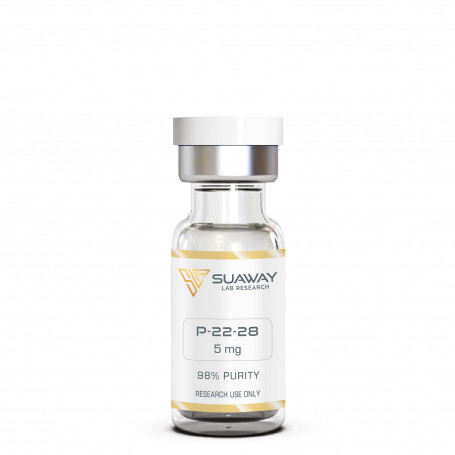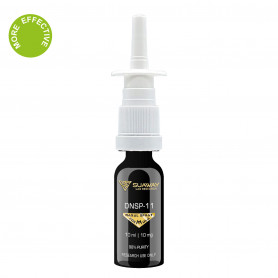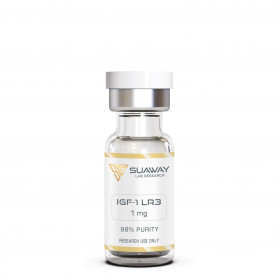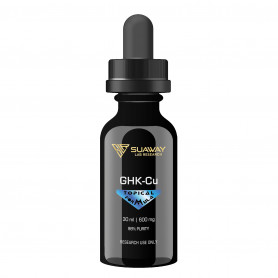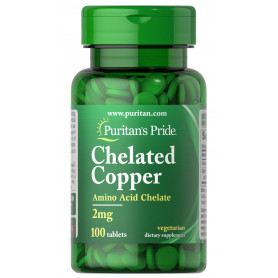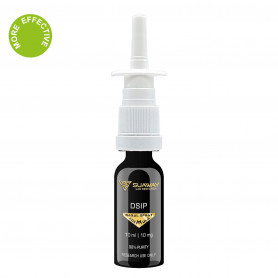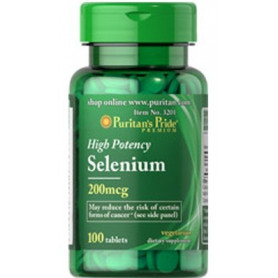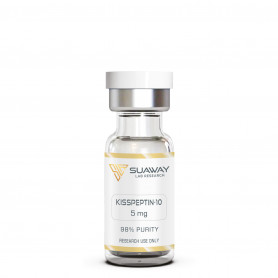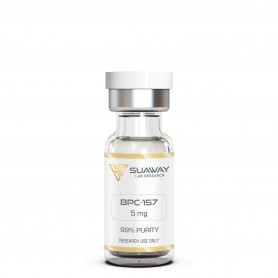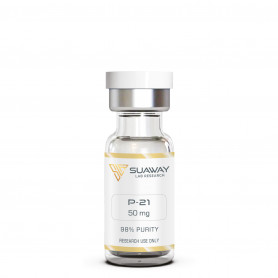PE-22-28 - 5 mg
PE-22-28 is a synthetic derivative of the naturally occurring peptide spadin which binds to TREK-1. TREK-1 is found in regions of the brain controlling mood, memory, and learning. It was specifically designed as an effective treatment to fight depression and as a potent stimulator of neurogenesis and synaptogenesis in the hippocampus.
PE-22-28 is being researched for applications including:
- Antidepressant activity
- Memory and learning
- Stroke recovery
- Neurodegenerative diseases such as Alzheimer’s
- Neurogenesis
Description
STRUCTURE
Sequence: GVSWGLR
Molecular Formula: C35H55N11O9
Molecular Weight: 773.8947 g/mol
Peptide purity: Greater than 98%
Other details: No TFA Salt, No Mannitol
Storage: Lyophilized peptide must be stored at -20°C and peptide solution at 4°C.
P-22-28 has low oral and excellent subcutaneous bioavailability.
DESCRITPION
The synthetic peptide PE-22-28 is derived from the found naturally peptide spadin. The TREK-1 (TWIK-related-potassium channel) receptor, the two-pore potassium channel that has been suggested as a target for the therapy of depression and as a potential neurogenic regulator, is antagonistic to spadin.
Particularly, TREK-1 is located in the brain areas in charge of emotion, memory, and learning. The prefrontal cortex, the amygdala, and the hippocampus are some of these regions. The excitability of the neuron is decreased when TREK-1 activity is stimulated, while the excitability is increased and a depolarization event is more likely when TREK-1 function is decreased. TREK-1 may aid in preventing excitotoxicity by lowering the neuron's excitability.
The heart, smooth muscle cells, lung tissue, the prostate, and certain regions of the pancreas are other tissues that contain TREK-1. TREK-1 has mostly been investigated as a target for antidepressant action, although it also has significant effects on anaesthesia, neuroprotection, and pain perception.
The iconic peptide for this class of artificial spadin analogs is PE-22-28. Over naturally occurring spadin, PE-22-28 has been proven to be more stable, have better antidepressant efficacy, and have neurogenic characteristics.
According to some research, sortilin therapy increases the development of both neurons or the synaptic connections that link them, resulting in resistance to depression.
It is important to remember that neurogenesis is one of the long-term effects of using antidepressants (such as SSRIs). One sign that depression is being appropriately treated and that antidepressants are effective is the development of new neurons. PE-22-28 has been shown to stimulate neurogenesis after just 4 days, which is far quicker than any antidepressant now in use. This implies that PE-22-28 may potentially be helpful in the treatment of neurodegenerative illnesses as well as other fields including learning and stroke recovery.
According to research, PE-22-28 has fewer adverse effects than any other therapy now in use and is more successful in reversing the signs and symptoms of depression. It has been shown that PE-22-28 can treat depression in as little as 4 days while having no negative impact on other TREK-1 channel-controlled processes.
The hippocampus is smaller (of lower volume) in people with depressive illness and other affective disorders, according to substantial evidence. Furthermore, studies have shown that chronic treatment of traditional antidepressants (5-HT or norepinephrine selective reuptake inhibitors) increases neurogenesis in the adult mouse hippocampus and increases hippocampal volume.
The fact that PE-22-28 can stop this volume loss by promoting neurogenesis suggests that it is effective in treating depression.
Just as significant as the effectiveness of spadin and PE-22-28 are their absence of adverse effects. There are several recognized adverse effects of current medications for depression, including suicidality, libido changes, and cognitive issues. The most common reason why individuals stop taking their antidepressants and are hesitant to start taking them again, even when their depression becomes worse, is because of adverse effects.
Because the TREK-1 receptor has been linked to pain sensitivity, seizure activity, and heart ischemia, there was initially fear that spadin might also have several adverse consequences. Additionally, there was worry that spadin and PE-22-28 would impede TREK-2, TRAAK, TASK, or TRESK channel currents, resulting in additional negative effects. However, studies in mice demonstrate that none of these adverse effects are seen, and PE-22-28 has one of the least significant side effect profiles of any approved or under investigational medication for depression.
It is generally known that antidepressant medications may increase neurogenesis in the hippocampus. According to research, PE-22-28 can carry out the same function but in a shorter amount of time. Studies on mice reveal that after only four days, PE-22-28 improves synaptogenesis and neurogenesis.
PE-22-28 seems to double the pace at which synapses develop in the case of synaptogenesis.
The rise in CREB seen after injection of PE-22-28 is another indicator that it is promoting cell proliferation in the brain. A transcription factor known as CREB (cAMP response element-binding protein) is linked to neural plasticity, memory formation, and the growth of spatial memory. Not only does CREB seem to be essential for neuronal development, but also neuronal protection. Researchers have discovered that CREB is downregulated in Alzheimer's disease, and they have long searched for a medication that may increase CREB to cure Alzheimer's.
While the hippocampus is an important factor in sadness, it is also an essential component of learning and memory. Research has shown that because of its highly malleable nature, it is susceptible to injury from several assaults. From sadness to anxiety to Alzheimer's disease, the hippocampus has been linked to several illnesses. Numerous disorders may be treated more effectively by increasing the body's capacity to recover after harm. Notably, the hippocampus's function in learning, memory, or spatial navigation raises the possibility that PE-22-28 or another TREK-1 antagonist may work well as a nootropic.
REFERENCES
J. Mazella et al., " Spadin, a sortilin-derived peptide, targeting rodent TREK-1 channels: a new concept in the antidepressant drug design" [PubMed]
A. Djillani et al., "Shortened Spadin Analogs Display Better TREK-1 Inhibition, In Vivo Stability and Antidepressant Activity" [PMC]
A. Djillani et al., "Role of TREK-1 in Health and Disease, Focus on the Central Nervous System" [PubMed]
R.S. Duman et al., "Regulation of adult neurogenesis by antidepressant treatment" [PubMed]
J.E. Malberg et al., "Increasing hippocampal neurogenesis: a novel mechanism for antidepressant drugs" [PubMed]
N. Katalanic et al., "Ketamine as a new treatment for depression: a review of its efficacy and adverse effects" [PubMed]
H.M. Ou Maati et al., "Spadin as a new antidepressant: absence of TREK-1-related side effects" [PubMed]
C. Devader et al., "In vitro and in vivo regulation of synaptogenesis by the novel antidepressant spadin" [PubMed]
A.J. Silva et al., "CREB and memory" [PubMed]
Qi Lei et al., "Response of the human detrusor to stretch is regulated by TREK-1, a two-pore-domain mechano-gated potassium channel" [PMC]
DISCLAIMER
This product is intendend for lab research and development use only. These studies are performed outside of the body. This product is not medicines or drugs and has not been approved by the FDA or EMA to prevent, treat or cure any medical condition, ailment or disease. Bodily introduction of any kind into humans or animals is strictly forbidden by law. This product should only be handled by licensed, qualified professionals.
All product information provided on this website is for informational and educational purposes only.

